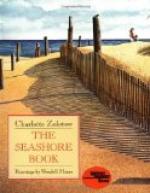This change of shell happens often to young Crabs. Older ones change only once a year. All the different kinds of Crab begin life as larvae or zoeas, and cast their shells as we have seen.
Crabs can see and hear and smell; and they must also have a fine sense of touch. I was once watching a big Crab eating his dinner under a rocky ledge in a large glass tank. As he tore his food, some of the bits, no larger than crumbs, fell and settled on the rocks below. Then I saw that a smaller Crab, with long pincers, was hiding under a rock. As the crumbs fell, he reached out his pincers and picked them up, one by one. Each bit was gravely carried to his mouth, and tucked in, and then he reached out for another. Though I was very close to the Crab, I could hardly see the tiny scraps which he was able to pick up so easily.
One of the strangest Crabs is the Hermit. You would think that Nature had played a joke on him, for he has only half a suit of armour. His tail part is soft. He would have a bad time in the sea, but for a dodge he has learnt.
The baby Hermit takes the empty home of a periwinkle. As he grows he needs a larger house, and so leaves the tight shell and pops his tail into a bigger one, generally a whelk shell. If he meets with another Hermit there is a battle, one trying to steal the other’s shell. Our coloured picture, page 35, shows some Hermits at war. Fighting, house-hunting, and moving house seem to be the Hermit’s favourite pursuits. But, whatever he does, his first care is to protect that soft tail of his. His right claw is large and strong, so he uses it to close the door of his stolen home.
Sometimes he has a lodger who lives on the roof. This lodger, as you will notice in our coloured picture, is the sea anemone. The Hermit and his lodger seem to be good friends, at least they seem to like each other’s company. There is no doubt that there are good reasons for this. We shall have more to say about this strange pair in our lesson on the sea anemones.
[Illustration: HERMIT CRAB IN WHELK’S SHELL.]
Another funny Crab is the Spider Crab. Its back is covered with reddish bristles, like so many hooks. These catch in the seaweed, and soon the Spider Crab is decorated with bits of weed. But that is not all. The artful Crab tears off other pieces of weed with its pincers, and attaches them to the hooks. It is another dodge, of course, to escape from enemies. The Lobster, whose picture you see, has a life-story much like that of the Crab. He, also, grows too big for his suit of armour, and casts it off in a wonderful manner, but only after a great deal of trouble. In his new suit he is very weak and soft—an easy prey to the first enemy to find him. He cannot defend himself then; he can only lie helplessly on his side, waiting for his coat to harden. He is so weak that his soft legs cannot bear the weight of his body.




